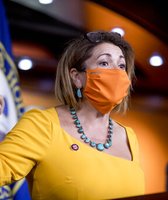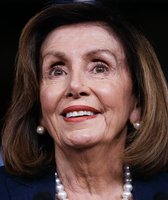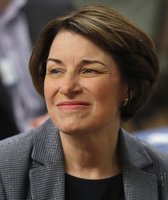Stand up for the facts!
Our only agenda is to publish the truth so you can be an informed participant in democracy.
We need your help.
I would like to contribute
When it comes to fighting climate change, the Democratic candidates agree: It’s critical that the United States rejoin the Paris Agreement. That position is a policy floor in the Democratic presidential primary.
Mike Pompeo, President Donald Trump’s secretary of state, announced in November 2019 the country’s withdrawal process from the agreement. Since then, Democrats say they want to rejoin nearly 200 countries trying to keep global temperatures from rising 2 degrees Celsius above pre-industrial levels.
All six candidates headed to the debate stage on Jan. 14 also want to implement some form of a Green New Deal, which was conceived as a congressional resolution in February 2019 to address climate change and economic disparities. (The bill is nonbinding, which means it can’t become law if it’s passed by Congress.)
All of the senators who qualified for the January debate — Amy Klobuchar of Minnesota, Bernie Sanders of Vermont, and Elizabeth Warren of Massachusetts — co-sponsored the resolution
Despite the many strategies where Democrats agree, the candidates’ proposals reveal differences in how they plan to approach climate change and what types of solutions they prefer. Here’s a rundown of the major candidates’ plans.
Former Vice President Joe Biden wants climate change to be a central focus of his foreign policy strategy.
"Global action requires American leadership," Biden said in a campaign video introducing his plan to fight climate change.
Biden’s strategy includes urging China to stop subsidizing coal exports and including emissions reduction goals in future U.S.-China agreements. Biden also wants countries to make enforceable commitments to reduce greenhouse gas emissions in global shipping and aviation.
He plans to build on efforts to reduce greenhouse gas emissions enacted under Obama’s administration by pushing for legislation that creates an "enforcement mechanism" for reduction targets.
While Biden wants to reduce reliance on fossil fuels, he also wants to ease the transition on coal miners and their families by establishing a Task Force on Coal and Power Plant Communities to help create high-paying union jobs for these communities.
In addition, Biden hopes to expand on Obama-era fuel efficiency standards and incentivize people to buy more electric vehicles. By the end of 2030, he wants to deploy over 500,000 new public charging outlets.
In total, Biden wants to make a $1.7 trillion federal investment over 10 years to address climate change and environmental justice issues. His website says reversing Trump-era corporation tax cuts will help pay for the plan.
In August 2019, Sanders rolled out a $16.3 trillion plan to execute the Green New Deal by integrating social justice issues into the fight against climate change.
He plans to pay for this through methods that include taxing the fossil fuel industry, cutting military spending and collecting income tax revenue from 20 million new jobs created to combat climate change.
"This is not a problem for tomorrow," Sanders said at an MSNBC climate forum in September 2019. "If we do not get our act together in an unprecedented way, the situation will become much worse."
Among his plan’s ambitious targets, Sanders wants the nation to power its electricity and transportation sectors by 100% renewable energy by 2030 and decarbonize the economy by 2050.
Under Sanders’ plan to implement the Green New Deal, new renewable energy would be publicly owned and managed by federal authorities and agencies. Sanders also wants to continue efforts under the Obama administration to make energy storage cheaper by investing $30 billion to commercialize long-lasting renewable energy technologies.
When it comes to foreign policy, Sanders wants trade deals to be renegotiated with a commitment to combating climate change. His plan also includes working to end investments in fossil fuels.
Warren said political dissonance should not get in the way of addressing climate change.
"You know what I think is the fundamental question right now? Is how we’ve gotten ourselves into this mess," she said during a CNN climate change town hall in September 2019. "It’s because of Washington."
Warren, who plans to federally invest $3 trillion to transition to renewable energy, wants the country’s energy sector to be carbon neutral by 2030.
Five years after that, she wants it to be powered completely by renewable sources.
Warren’s "green manufacturing" plan says the corporations tax she hopes to implement can help pay for her climate change proposals, which include investing $2 trillion over 10 years in "green" research, manufacturing and exporting.
She wants the United States to invest $1.5 trillion over a decade to make federally-owned "clean energy products" to use at local, state and federal levels in addition to exports.
Warren promises to make renewable energy more accessible to tribal communities.
In addition, the Massachusetts senator is proposing a zero-emissions requirement for new light- and medium-duty vehicles by 2030.
Warren wants to commit $100 billion over a decade to lower the price for countries to buy American "clean energy" technology.
Pete Buttigieg, a former mayor of South Bend, Ind., is taking an approach to mitigate climate change that includes offering market incentives to reduce greenhouse gas emissions.
In particular, Buttigieg’s climate plan says he would try to pass economy-wide carbon tax legislation that would increase annually. The revenue from the tax would be given back to Americans in the form of rebates.
He said at the Democratic presidential debate in December that he believes addressing climate change should be a nationwide effort.
"I want to make sure that our vision for climate includes people from the autoworker down the block from me in South Bend to a farmer a few minutes away so that they understand that we are asking, recruiting them to be part of the solution," he said.
Buttigieg is aiming to double the "clean energy" generated in the United States by 2025 and make the electricity sector and new passenger vehicles emissions free by 2035.
In addition to reducing emissions output, Buttigieg is proposing a carbon capture program, which will include storing carbon dioxide underground and using it for manufacturing products.
On the international front, Buttigieg is proposing to create a Tipping Points Coalition for high-emitting countries to commit to reducing emissions.
Market incentives are also central to Klobuchar’s plan to make the United States less dependent on fossil fuels.
Klobuchar wants to implement a carbon pricing system that isn’t regressive, meaning it won’t disproportionately impact Americans with lower incomes. Her plan says the system would help pay for investments made to address climate change, including a $1 trillion infrastructure package.
During the CNN climate town hall in September, Klobuchar said she would work with Congress to develop what the pricing system would look like, such as a carbon tax or cap-and-trade program. Klobuchar said during an interview in January with Iowa PBS that she’d support a dividend as well.
Her plan says she will try to implement a tax on carbon-intensive imports.
Klobuchar’s proposal to expand renewable energy also includes simplifying the permit process for renewable energy projects on federal lands.
In her Iowa PBS interview, Klobuchar said the country can look to the Midwest to expand renewable energy projects.
"Let’s acknowledge there’s a lot of gain for us in the middle of the country," she said.
Klobuchar’s plan also says she would strengthen EPA rules to reduce methane leaks from oil and gas, which contribute to greenhouse gas emissions.
Billionaire activist Tom Steyer has made clear one thing he wants to do during his first day in office: declare climate change a national emergency.
Despite the challenges it will take to combat the issue, Steyer remains hopeful.
At the December presidential debate, he said that addressing environmental issues can lead to the creation of millions of jobs.
"Our biggest crisis is our biggest opportunity," Steyer said.
His climate plan says he will encourage Congress to fund a Civilian Climate Corps to create 1 million jobs for Americans.
Steyer wants to reduce emissions in the energy sector by requiring all new electricity sources to be carbon-free by 2030 and utilizing entirely "clean electricity" by 2040. He plans for the country to invest $250 billion in modernizing the electrical grid.
He’s proposing to require new passenger cars, trucks, medium-duty vehicles, and heavy-duty and freight vehicles to meet a "100% clean standard" by 2035.
Steyer is promising to invest $2 trillion to make infrastructure more resilient and energy efficient.
Steyer’s plan says he’ll work to end coal financing by the International Monetary Fund and World Bank. He also wants to recruit other countries to reduce emissions in the aviation sector.
Our Sources
Joe Biden for President, Climate, accessed Jan. 8, 2020
Bernie Sanders, Issues: The Green New Deal, accessed Jan. 8, 2020
Elizabeth Warren, Tackling the Climate Crisis Head On, accessed Jan. 8, 2020
Pete Buttigieg for President, Mobilizing America: Rising to the Climate Challenge, accessed Jan. 8, 2020
Amy Klobuchar for President, Senator Klobuchar’s Plan to Tackle the Climate Crisis, accessed Jan. 8, 2020
The White House, Remarks by President Trump and Vice President Pence in a Roundtable on Small Business and Red Tape Reduction Accomplishments, Dec. 6, 2019
Obama White House, Climate Change and President Obama’s Action Plan, accessed Jan. 8, 2020
YouTube, Watch Live: MSNBC’s Climate Forum 2020 (DAY 1) | MSNBC, Sept. 19, 2019
No Fossil Fuel Money Pledge, Presidential Candidate Signers, accessed Jan. 10, 2020
YouTube, Elizabeth Warren: Where Trump is right now is a nightmare, Sept. 5, 2019
YouTube, 6th Democratic Debate hosted by PBS NewsHour and Politico, Dec. 19, 2019
CNN, Climate Crisis Town Hall With Sen. Amy Klobuchar (D-MN), Presidential Candidate, Sept. 4, 2019
YouTube, Klobuchar: If we don’t address climate change, it will be at our economic peril, Jan 3, 2020
YouTube, WATCH: On climate change, Steyer says, ‘Our biggest crisis is our biggest opportunity’, Dec. 2019https://www.youtube.com/watch?v=5cGj8GDOsmM
Tom Steyer, Tom’s Justice-Centered Climate Plan, accessed Jan. 10, 2020
Climate Transparency, G20 Brown to Green Report 2018, accessed Jan. 9, 2020
IPCC, Global warming of 1.5°C, October 2018
Green Climate Fund, About the fund, accessed Jan. 10, 2020
Congress.gov, S.Res.59 - A resolution recognizing the duty of the Federal Government to create a Green New Deal, Feb. 7, 2019
No Fossil Fuel Money Pledge, Presidential Candidate Signers, accessed Jan. 10, 2020
UNFCC, Paris Agreement, accessed Jan. 10, 2020
Tweet by Secretary Pompeo, Nov. 4, 2019
United States Environmental Protection Agency, Global Greenhouse Gas Emissions Data, accessed Jan. 10, 2020






























